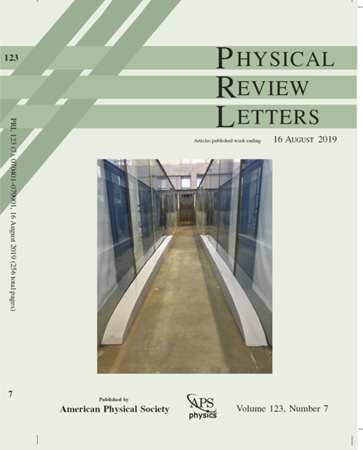二维莫伊里极电子晶体
IF 9
1区 物理与天体物理
Q1 PHYSICS, MULTIDISCIPLINARY
引用次数: 0
摘要
二维摩尔材料已成为实现电子量子相的最通用平台。在这里,我们探索了 WSe2/WS2 摩尔超晶格中相关态的稳定性起源。我们发现,超快电子激发导致莫特态部分熔化的时间尺度比电荷跳跃积分预测的时间尺度长 5 倍,而且熔化率是热激活的,单孔莫特态和双孔莫特态的激活能分别为 18±3 和 13±2 meV,表明电子-声子耦合显著。单孔莫特态的密度泛函理论计算证实了极子的形成,并得出空穴-极子结合能为 16 meV。这些发现揭示了电子-电子和电子-声子相互作用在稳定过渡金属二卤化物莫伊里界面的极子莫特绝缘体中的密切相互作用。本文章由计算机程序翻译,如有差异,请以英文原文为准。

Two-Dimensional Moiré Polaronic Electron Crystals
Two-dimensional moiré materials have emerged as the most versatile platform for realizing quantum phases of electrons. Here, we explore the stability origins of correlated states in moiré superlattices. We find that ultrafast electronic excitation leads to partial melting of the Mott states on timescales 5 times longer than predictions from the charge hopping integrals and that the melting rates are thermally activated, with activation energies of and for the one- and two-hole Mott states, respectively, suggesting significant electron-phonon coupling. A density functional theory calculation of the one-hole Mott state confirms polaron formation and yields a hole-polaron binding energy of 16 meV. These findings reveal a close interplay of electron-electron and electron-phonon interactions in stabilizing the polaronic Mott insulators at transition metal dichalcogenide moiré interfaces.
求助全文
通过发布文献求助,成功后即可免费获取论文全文。
去求助
来源期刊

Physical review letters
物理-物理:综合
CiteScore
16.50
自引率
7.00%
发文量
2673
审稿时长
2.2 months
期刊介绍:
Physical review letters(PRL)covers the full range of applied, fundamental, and interdisciplinary physics research topics:
General physics, including statistical and quantum mechanics and quantum information
Gravitation, astrophysics, and cosmology
Elementary particles and fields
Nuclear physics
Atomic, molecular, and optical physics
Nonlinear dynamics, fluid dynamics, and classical optics
Plasma and beam physics
Condensed matter and materials physics
Polymers, soft matter, biological, climate and interdisciplinary physics, including networks
 求助内容:
求助内容: 应助结果提醒方式:
应助结果提醒方式:


